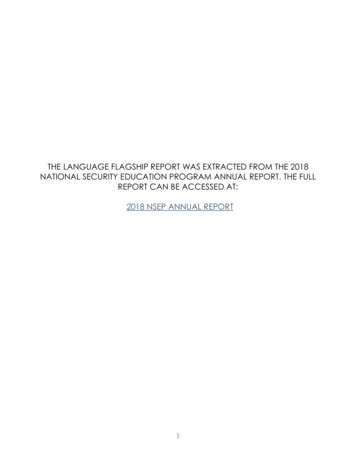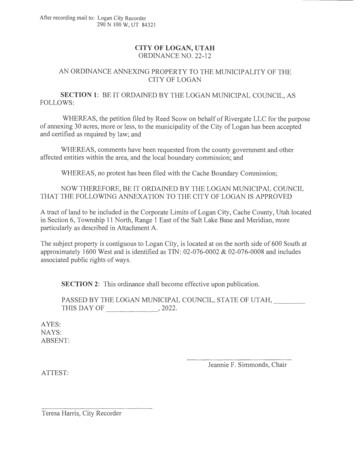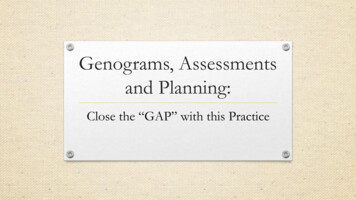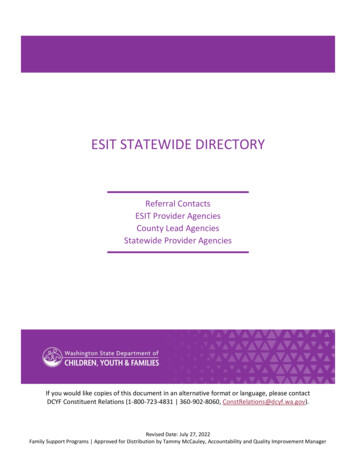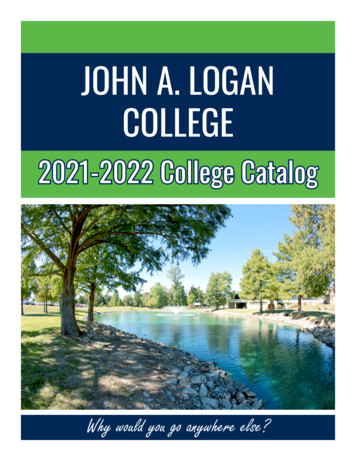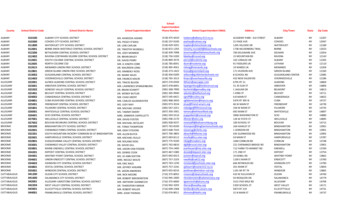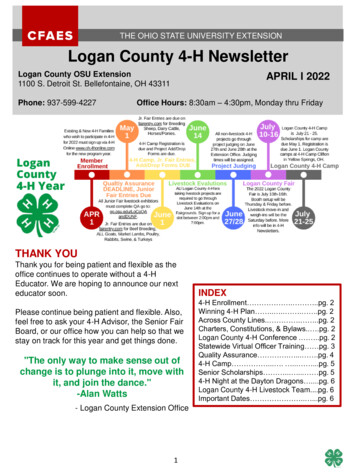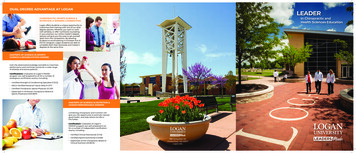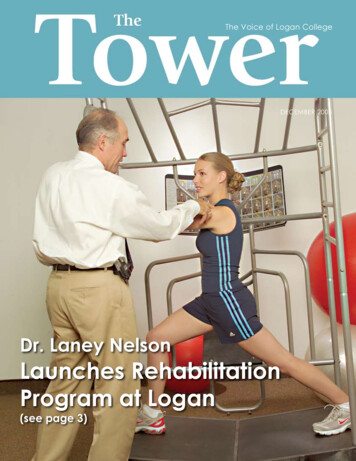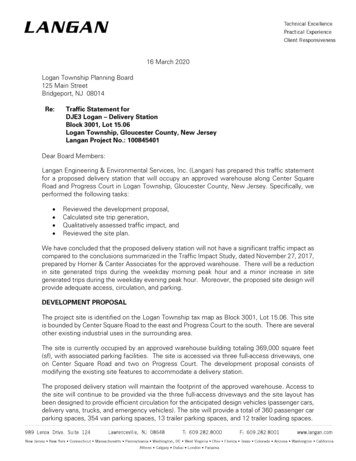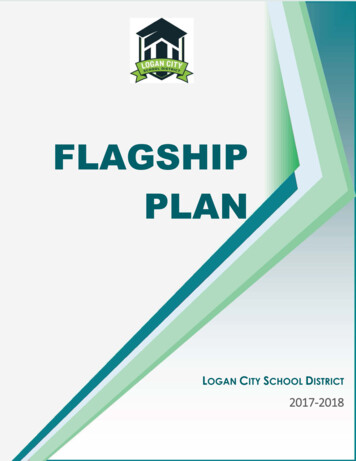
Transcription
FLAGSHIPPLANLOGAN CITY SCHOOL DISTRICT2017-2018
101 WEST CENTER STREET, LOGAN, UTAH 84321WWW.LOGANSCHOOLS.ORGI' 435 755 2300I 435 755 23110“If you want to go fast, go alone. If you want to go far, go together.”African proverbDear Colleagues:In education, the distinction between going fast or going far is comparable to having short orlong-term goals. As educators, our desire should extend beyond simply addressing short-termlearning goals and should include helping students develop the attitudes, behaviors, and skillsthat promote long-term success. Our focus must include an understanding of what it takes tofiguratively help students go far, not just fast.The concept of going far is encapsulated in the Logan City School District’s mission which is:Ensure all students leave our schools ready to create a positive future forthemselves and their community.Our ability to meet this goal increases when educators work together to identify students’ needsand then systematically develop plans to effectively address those needs. Because we knoweducators are more successful when they work together, we believe that Team Effort AlwaysMatters (TEAM). I am grateful for dedicated employees who support one another in thisendeavor and who, through their willingness to work as part of TEAM Logan, support ourstudents in their personal growth.This booklet outlines our District mission, communicates our goals for student achievement, anddescribes guiding principles for our work as educators. As we apply our collective knowledge andremain focused on common goals, I am convinced we will help an ever-increasing number ofstudents succeed.Thank you for your commitment to the students of the Logan City School District. I am honoredto serve with you as part of TEAM Logan.Warmly,Frank SchofieldFrank Schofield, SuperintendentLogan City School District
TABLE OF CONTENTSOur Mission .1Professional Learning Communities .2Framework .3High Reliability Organizations .4High Reliability Schools .4Defined Autonomy .5Student Achievement Non-Negotiables .5Instructional Practice Non-Negotiables .5Positive Behavior Intervention and Support.6Pillar 1 – Establish Expectations/Rules .6Pillar 2 – Explicitly Teach Expectations/Rules .6Pillar 3 – Systematically Reinforce Expectations/Rules .7Pillar 4 – Correct Behavioral Errors .7Articulated Learning Objectives and Targets .8Gradual Release of Responsibility .9I Do .9We Do .9You All Do .9You Do .9Frequent Opportunities to Respond .10Frequent Assessment .11Assessment and Grades .11Ongoing Feedback.12Differentiation and Personalized Learning .13References.14FLAGSHIP PLAN i
LOGAN CITY SCHOOL DISTRICTFLAGSHIP PLANOUR MISSIONWe invite all employees to ask themselves:§ What is the purpose of our district?§ Why do we engage in the work we do?Clear and consistent answers to these questionsallow each of us to align our actions with a definedpurpose. This helps ensure all District employeeswork toward common goals.When each of us understands the Logan City SchoolDistrict mission and when we work together as partof TEAM Logan, we help all of our students preparefor successful futures.Thank you for your commitment to helping ourstudents reach that goal.Upon graduation from Logan High School, somestudents will embark on a path of additional study atthe university level; others will pursue technicaltraining for a specific career field. Our role is not todetermine the specific post-secondary opportunitiesindividual students might pursue, but rather toensure all students develop the attitudes, behaviors,and skills that will promote their success inwhichever path they choose. As our studentssucceed in their post-secondary endeavors, they arebetter able to create a positive future forthemselves and their families, and to favorablyinfluence their community. For this reason, theLogan City School District has identified our missionas:Ensure all students leave ourschools ready to create a positivefuture for themselves and theircommunity.This mission influences our long-term plans as adistrict and drives every decision we make. The goalswe set, the commitments we make to one anotheras professional members of a learning community,and the specific behaviors we demonstrateinfluence our ability to accomplish the purposeof the District.FLAGSHIP PLAN1
LOGAN CITY SCHOOL DISTRICT 2017-2018PROFESSIONAL LEARNING COMMUNITIESThe Professional Learning Community (PLC) modelprovides schools a framework for buildingeducators’ capacity to work as members of highperforming, collaborative teams that focus onimproving student learning.As stated in Learning by Doing, "the members of aPLC create and are guided by a clear and compellingvision of what the organization must become inorder to help all students learn. They makecollective commitments clarifying what eachmember will do to create such an organization, andthey use results-oriented goals to mark theirprogress" (DuFour, DuFour, et al. 2006).Professional Learning Communitiesvpromote clarity of purpose and acollaborative culture.vare able to turn collective inquiryinto best practice,vare action oriented,vand are committed to continuousimprovement.The Logan City School District recognizes thatinvestment in educator learning has a powerfulimpact in improving student achievement. For thisreason, the professional learning communityframework is a key component to our success, anda reflection of our philosophy thatTeamEffort Always Matters.PLC NON-NEGOTIABLESThe following non-negotiables ensure the successfulimplementation of Professional LearningCommunities throughout the District:1. Every educator actively participates as a part ofan organized PLC team.2. Every PLC Team meets weekly for at least40-60 uninterrupted minutes.3. Every PLC team collaboratively develops andadministers Common Formative Assessments(CFA) based on identified essential learnings. PLC team uses CFA data to answer the4. Everyfollowing questions:a. What do we want students to learn?b. How will we know if students arelearning? c. How will we respond when studentsdon't learn?d. How will we enrich and extendlearning for students who areproficient?5. Every PLC team uses the Logan City SchoolDistrict PLC Framework (P. 3).FLAGSHIP PLAN2
LOGAN CITY SCHOOL DISTRICT 2017-2018Logan City School District Professional Learning Community FrameworkEnsuring High Levels of Learning for EVERY StudentTEAM QUESTIONSHigh-leverage questionsasked by every teamIs each teacher clear onthe guaranteed essentialskills students will berequired to learn?Have we developed anagreed upon pacingguide for the guaranteedessential skills?Have we come toconsensus on thestandard a student mustachieve to be proficient?Have we identifiedindividual students andtheir specific needs?Are we intervening in atimely manner once wehave identified thestudents specific needs?CORECURRICULUMLEADER ACTIONSHigh-leverage questionsasked of every smentsREVIEWCFA rventionExtensionRE-assess"Which essential standardshave been LEARNED?"COLLABORATION"What EVIDENCE can yourteam show me thatstudents have learned it?""What are the SPECIFICNAMES of students whodidn't get it?""What evidence do youhave that your teamINTERVENED / EXTENDED?""What evidence do youhave that your teamprovided MULTIPLEOPPORTUNITIES for thestudent to demonstrateproficiency?" Credit: Bob Sonju, 2015FLAGSHIP PLAN 3
LOGAN CITY SCHOOL DISTRICT 2017-2018HIGH RELIABILITY ORGANIZATIONS (HRO)Dr. Robert Marzano stated, “In industries wheremistakes and errors lead to significant and farreaching consequences - such as nuclear powerplants, air traffic control towers, and electrical powergrids - organizations must adjust their operations toproactively prevent failure” (Marzano, Warrick &Sims, 2014). Organizations that perform as definedby Marzano are often termed “High ReliabilityOrganizations.”High Reliability Organizations consistently: Flexibility Formalized operating procedures A focus on best practices Rigorous performance evaluations Clean, well-functioning campusesFurther, High Reliability Schoolsdemonstrate the ability to.consistently Ensure high levels of student achievement. Perform successfully under high stakesconditions. Ensure high quality instruction in everyclassroom. Demonstrate low variability in the qualityof work between individuals and sites. Ensure low variability in the quality ofinstruction within and between schools. Mindfully monitor for the early signs offailure and respond quickly. Ensure mindful monitoring for the early signsof failure and respond quickly. Use various evidence-based practices inpursuit of error-free performance. Ensure superior executionevidence-based practices.HIGH RELIABILITYSCHOOLSofeffectiveGuaranteeing each of these elements exists in everyclassroom in the Logan School District ensuresall students learn at high levels and leave ourschools ready to create a positive future forthemselves and their community.Although schools are not typically thought of asHigh Reliability Organizations, the comparisonis appropriate considering the importance of ourwork.Marzano also stated, “A highreliability school, by definition, monitors theeffectiveness of critical factors within the systemand immediately takes action to correct thenegativeeffectsof anyerrorsthatoccur” (Marzano, Warrick, & Sims, 2014).High Reliability Schools have several things incommon, including:§ Rigorous, clear, shared goals§ Real-time, understandable, comprehensivedata systems§ Collaborative environmentsFLAGSHIP PLAN 4
LOGAN CITY SCHOOL DISTRICT 2017-2018DEFINED AUTONOMYAccording to Dr. Robert Marzano (2009) HighReliability Schools employ defined autonomy - aconcept that focuses on district-defined, nonnegotiable common goals, and a system ofaccountability supported by assessment tools.Defined autonomy creates an effectivebalance between centralized direction andindividualizedempowerment,which allows building-level staff stylisticfreedom whileensuringstudentachievement. Centralized direction is provided through systemwide parameters termed non-negotiables. Nonnegotiables are important enough to thesuccess of the organization that theirinclusion is expected in all cases. Nonnegotiables are selected because they reflectthe values and goals of the organization.Student Achievement Non-Negotiables providemeans for monitoring our success in preparingstudents to leave our schools ready to create apositive future for themselves and theircommunity.InstructionalPracticeNonNegotiables provide means for applyingevidence-based practices proven to positivelyimpact student learning. For these reasons, theLogan City School District has established nonnegotiables for student achievement andinstructional practice as follows:STUDENT ACHIEVEMENTNON-NEGOTIABLES§Every high school student in the Logan CitySchool District will reach each of thefollowing four ACT College ReadinessBenchmarks:§ English§ Mathematics§ Reading§ ScienceEvery K-3 student will achieve typical orabove typical growth in reading as measuredby the DIBELS assessment § Students who takestate directed end of will achieve a Student level assessmentsGrowth Percentile (SGP) equal to or greaterthan 50.§INSTRUCTIONAL PRACTICENON-NEGOTIABLES§ Every teacher will effectively utilize positivebehavior supports.§ Every teacher will articulate learning objectivesand targets.§ Every teacher will provide frequentopportunities for students to respond.§ Every teacher will employ gradual release ofresponsibility.§ Every teacher will utilize frequent assessment.§ Every teacher will provide ongoing feedback.§ Every teacher will provide all students withdifferentiated/personalized learning.FLAGSHIP PLAN 5
LOGAN CITY SCHOOL DISTRICT 2017-2018POSITIVE BEHAVIORINTERVENTION AND SUPPORTAll students benefit academically and socially when their classroom and school environments are positive,preventive, and responsive. (Guerra & Williams, 2003; Horner, Sugai, & Anderson, 2010; Zins, Weissberg, Wang,& Walberg, 2004).Explicitly teaching common routines and procedures helps support positive behavior and reduce behavioralerrors. Routines and procedures help clarify classroom rules in frequently occurring circumstances, (i.e.,routines for transitions, conversational levels, personal needs, turning in homework, etc.).Positive Behavior Intervention and Support (PBIS) is a framework for managing school and classroom behavior. Itis based on data collection and planning in four critical areas referred to as the four pillars of PBIS.PBISPositive BehaviorIntervention and SupportPILLAR 1PILLAR 2EstablishExpectations/RulesExplicitly TeachExpectations/RulesPILLAR 3ReinforceExpectations/RulesPILLAR 4CorrectBehavioral ErrorsPBIS - PILLAR 1ESTABLISH EXPECTATIONS/RULESEducational research strongly establishes that whenteachers hold high expectations for students,students are much more likely to learn academic andbehavioral skills.Proactive classroom rulescommunicateandestablishexpectations.Classroom rules and expectations should align withschool-wide rules and expectations.The following list outlines characteristics of effectiveand proactive classroom rules: Prioritize expectations by limiting the numberto three to five classroom rules. State explicit behaviors positively. Use developmentally appropriate language(match wording and vocabulary to student age,functional level, and skill level). State explicitly what desired behavior lookslike and sounds like. Make rules observable and measureable(able to be counted or quantified formonitoring). Post the rules publicly for all to see.FLAGSHIP PLAN 6
LOGAN CITY SCHOOL DISTRICT 2017-2018PBIS - PILLAR 2EXPLICITLY TEACH EXPECTATIONS/RULESTeaching students to understand basic school-wideand classroom rules/expectations is proactive andoften prevents behavioral problems from occurring.The following outlines a suggested instructionalsequence for teaching behavioral expectations: Define expectation/rule. Practice the behavior (in setting wherebehavior is required, if possible). Discusswhatwillhappenwhenexpectations/rules are followed and what willhappen if behavioral errors occur. Provide additional opportunities to makechoices (e.g. preferred seating in theclassroom). Provide rationale for expectation/rule. Provide tangibles (e.g. homework passes,school supplies). Teachcriticaldiscriminationofexpectation/rule (model examples and nonexamples). Share feedback with parent/guardian (e.g.positive notes or phone calls to home).PBIS - PILLAR 3SYSTEMATICALLY REINFORCEEXPECTATIONS/RULESReinforcement systems should be aligned withexpectations/rules and of sufficient intensity tobuild/maintain desired behavior. In general, there isa simple set of rules to follow to make reinforcementmore effective. These rules are referenced in anacronym format as IFEED-AV in The Tough Kid Bookby Rhode, Jenson and Feavis (2010) as follows:IImmediate - the more immediate, the betterFFrequent - more often for a new behaviorEEnthusiasm - listen to the tone of your own voiceEEye Contact - use whenever possibleDDescriptive - be specific in your praiseAAnticipation - build excitement, be mysteriousVVariety - create variety in reinforcement providedPBIS - PILLAR 4CORRECT BEHAVIORAL ERRORSOncebehavioralexpectations/ruleshavebeen established and explicitly taught, and asystem of reinforcement for lemented for school-wide and ion of behavioral errors and re-teaching ofbehavioral skills should be implemented.Introducing, modeling, and reinforcing positivesocial behavior are important to a student’seducational experience.Teaching behavioralexpectations and rewarding students for followingthem is a much more effective approach thanwaiting for misbehavior to occur before responding.FLAGSHIP PLAN 7
LOGAN CITY SCHOOL DISTRICT 2017-2018ARTICULATED LEARNING OBJECTIVESAND TARGETSClearly communicated learning objectives andlearning targets are an essential part of the learningprocess.Learning (Instructional) Objectives guide theteacher’s instruction,provide direction forlearning,andestablishafoundationfor assessment.Learning(instructional)objectives focus on student learning over time (i.e. aunit, month, or the school year).Learning Targets guide student learning anddescribe in student friendly language theinformation, skills, and reasoning processesstudents will come to know deeply as part of aspecific lesson. Learning Targets focus on theprogress that students make as they work towardthe long-term objectives identified by teachers .There are multiple ways to communicate learningtargets to students, including orally and in writing.In order to be effective, those targets mustbe expressed concisely and be clear to boththe teacher and the student. This process guidesthe teacher’sbehaviors,andhelpsstudents develop the metacognitive skills thatsupport future learning.Before preparing a lesson, the teacher should havea clear idea of what essential learning targets willbe addressed and what the student should be ableto do, understand, and care about as a result of theteaching and learning. The identification of essentiallearning targets is most effective when identified aspart of the standard work of a ProfessionalLearning Community (PLC). This processhelps answer the first question of a PLC: What dowe want students to learn?What learning is expectedWhen the students will learnHow the students will be heldaccountable for their learningWhere students are in the learningprocess and where they need to beObjectives and learning targets can be measured bythe following success criteria:My learning targets are tied tomy long-term objectives.My learning targets are visibleduring instruction, and arecommunicated in studentfriendly language.We refer back to thelearning targets throughoutthe lesson.My students can show or explainwhat they are learning and why.Once learning objectives and targets are identified,the teacher develops success criteria that allowstudents and teachers to assess and monitormastery. Learning objectives and targets shouldclarify the following:FLAGSHIP PLAN 8
LOGAN CITY SCHOOL DISTRICT 2017-2018GRADUAL RELEASE OF RESPONSIBILITYAs stated by Douglas Fisher and Nancy Frey, “Thegradual release of responsibility framework is atemplate for powerful and effective instruction. Theframework is built on evidence about how learningworks. Simply put, we learn by first observing orlistening to others and then apprenticing ourselvesusing new knowledge and practicing new skills untilthey become our knowledge and skills” (Fisher &Frey, 2016).WE DO is the guided instruction phase. This phaseconsists of the following:The gradual release of responsibility framework iseffective with students at all grade levels and inevery subject area. The phases of a gradual releaseof responsibility can be deployed in any order, toalign with where students are in the learningprocess. The gradual release of dintentionally shifts cognitive responsibility from theteacher as model to independent application by thelearner/student.YOU ALL DO is the collaborative learning phase. Thisphase consists of the following:The gradual release of responsibility consists of thefollowing four phases:YOU DO is the independent learning phase. Thisphase consists of the following: I DO WE DO YOU ALL DO YOU DOI§ Immersing students in new ideas and skillsthrough questions, prompts, and cues.§ Teacher listens for and redirectsmisconceptions High level of support for students as theyengage with the new learning. Small group environments where studentsapply new skills and knowledge and consolidatetheir understanding with the input and supportof their peers. Opportunity for students to utilize, leverage,and improve upon the soft skills ofcommunication, leadership, and negotiation.§ Independent learning that helps students buildfluency, review the knowledge and skillsthey’ve acquired, and apply them to newsituations inside and outside of the classroom.§ Students take what they have learned andmake it their own.DO is the focused instruction phase. This phaseconsists of the following: Communicate the lesson’s learning objectivesand targets. Communicate the relevance of objectives andtargets to real world application. Model how experts think about the content oruse targeted skills.FLAGSHIP PLAN 9
LOGAN CITY SCHOOL DISTRICT 2017-2018FREQUENT OPPORTUNITIES TO RESPONDStudentswhoexperiencefrequentopportunities to practice correct responsesduring instruction demonstratefewerlearning errors and misbehaviors. Whenprovided with frequent opportunities torespond,studentsexperiencegreatersatisfaction with school and develop an abilityto persist in the face of difficulty orabsence of extrinsic rewards.Teachers should explicitly utilize strategies thatprovide frequent response opportunitieswhenever teaching academic skills, social skills,collaboration skills, self-management skills, andcareer skills.Frequent opportunities to respond movestudents from passive engagement(i.e.silently listening) to active engagement (i.e.responding to a teacher prompt).Onlyactivities where the students’ engagement withthe learning is visible (i.e. note taking, verbalresponses,etc.) are considered activeengagement, and this is the level ofengagement that frequent opportunities torespond promote.Through the implementation of frequentopportunities to respond during ments, student growth, and an overallsatisfaction with the school experience.Research has proven that increasing s to respond during instructionresults in the following:§ Increase in academic performance§ Decrease in disruptive classroom behavior§ Provision of ongoing feedback to the student§ Assurance that the teacher is aware of wherestudents are in their learning or neededadjustments to instruction to meet thestudent’s needs can be quickly made§ Assurance that each student is regularly ableto show growth towards proficiency in his orher learningAn opportunity to respond can be provided inseveral ways, including the following: Choral responses Individual responses Student response cards Audience response systems White boards Any other methods that allow students to indicatetheir response to a prompt from a teacherFLAGSHIP PLAN 10
LOGAN CITY SCHOOL DISTRICT 2017-2018FREQUENT ASSESSMENTFrequent assessment allows teachers to answerthe key question of a Professional LearningCommunity, “how will we know if students arelearning?” Effective formative assessmentreduces the gap between current and desiredperformance, and provides the necessaryinformation for the teacher to plan futureinstructional activities.Assessmentincludesthevarietyofteacher behaviors used to collect data onstudent achievement, while evaluation is theprocess of making judgements based on thatdata. Both are essential to the teaching/learningprocess.Caroline Wylie states that grading work meantfor formative purposes can be highlyproblematic (Heitin, 2015), especially if thegoal is to get students to reveal whattheydon’t understand. Giving studentscomments about their work is helpful, butfeedback in the form of grades can bediscouraging.ASSESSMENT AND GRADESGrades are intended to communicate studentmastery of academic standards. Consequently,grades should not be calculated based onanything other than student mastery of essentiallearning. Grading practices that include studentbehavior in the calculation of a final grade (i.e.Effective assessment may be formal or informal,attendance or work completion) do notand is used frequently to measure mastery ofaccurately reflect the academic progressidentified learning objectives. In a highstudents have made, and fail to provide clarityperformingclassroom,formativeassessment resultsareusedto makeregarding what changes are needed to improvestudent performance. Grades should beinstructional adjustments, to ensure studentdetermined by student performance onmastery of key content and to personalizesummative assessments that have been designedinstruction based on student needs. Summativeto measure mastery of essential standards.assessments are used to generate final reportsof a student’s learning.The following table illustrates the relationshipsbetween different types of assessments and theA single assessment should not be used for bothroles they each may play.formative and summative purposes.TYPES OF ativeSummativeDuringInstructionAfter InstructionPurpose of AssessmentTo find out what students know before instructionalplanning begins and to guide lesson planning,Show students you value their previous learning.To check out students’ understanding throughout theinstructional unit.To make adjustment to flexible groups and instructionalpacing.To assess what students have learned at the end of a unit.FLAGSHIP PLAN 11
LOGAN CITY SCHOOL DISTRICT 2017-2018ONGOING FEEDBACKFeedback is the communication betweenstudents and teachers that illustrates whetheror how learning is taking place.Feedback is more consistently related to studentachievement than any other teacher behavior.Based on an analysis of 195 meta-analyses, JohnHattie calculated that feedback has an effectsize of 0.73, which is to say that effective use offeedback almost doubles the amount of growthfor each individual student. According to Hattie,“An important notion is that feedback thrives onerror, but error should not be considered s where feedback is incorporatedeffectively demonstrate a culture where error isperceived as an opportunity for learning andgrowth (Hattie, 2009).Hattie notes that the most important feedbackin a classroom is often the feedback that informsthe teacher of the students' current levels oflearning. That is the why frequent assessmentis one of our non-negotiables. It is the tool bywhich teachers receive feedback from studentsregarding their learning.As we consider effective feedback for students,there are three questions that feedbackshould answer for students :§ Where am I going?§ How am I going to get there?§ Where do I need to go next?There are multiple ways to provide feedback tostudents, and feedback is more effectively providedwhen it includes the following elements:Goal Referenced: effective feedback requires that astudent have a goal he/she is working toward, and thefeedback illustrates how the student's currentperformance relates to the goal.Actionable: Feedback that is concrete and specificwill inform a learner exactly what they should dodifferently in the future to reach a learning goal.User-Friendly: Feedback is delivered in a waythat allows it to be understood by the student. Thevolume of feedback and level of technical detailshould be modified based on the needs andabilities of the lea
Thank you for your commitment to the students of the Logan City School District. I am honored to serve with you as part of TEAM Logan. Warmly, Frank Schofield Frank Schofield, Superintendent Logan City School District 101 WEST CENTER STREET, LOGAN, UTAH 84321 WWW.LOGANSCHOOLS.ORG I' 435 755 2300 0 I 435 755 2311
